-
Welcome! The TrekBBS is the number one place to chat about Star Trek with like-minded fans.
If you are not already a member then please register an account and join in the discussion!
You are using an out of date browser. It may not display this or other websites correctly.
You should upgrade or use an alternative browser.
You should upgrade or use an alternative browser.
Photo request -- Enterprise hangar deck studio miniature
- Thread starter Professor Moriarty
- Start date
^Please, I'm not trying to be confrontational or personal. This is interesting, and I'd like to explore the question more fully. It looks to me like if we disregard the dimensions of the doors in the profile cutaway, then the rest of the bay as shown could be a somewhat closer fit. That's my hypothesis; now I'd be interested to see you test it so we'll know whether it's right or wrong.
trevanian
Rear Admiral
The single very long & comprehensive interview with FJ that I have read, which was in ENTERPRISE INCIDENTS magazine, indicates everything he did that wasn't whole cloth invention derived from hours and hour and hours of studying film clips ... I don't think he mentions the drawing in TMOST at all (and I thought years back that everybody had declared the line drawings in that book as invalid, though I can't point to anything other than memory.)Although I'm still annoyed at Franz Joseph for not realizing that the "pipe cathedral" behind the engine-room grille was a forced-perspective set piece.
Well, it wouldn't come as a surprise once you assume (what I do) that The Making of Star Trek (with the studio set blueprint and its forced-perspective "cathedral") was all he basically worked with.
His hangar deck observation corridor (with the pairs of triple windows) clearly reveals that either he had never seen the actual shuttlebay VFX footage or didn't notice.
I don't know if there are other particulars that interview might shed light upon, but it is definitely in the EI all interviews issue, plus I guess a previous one as well.
The single very long & comprehensive interview with FJ that I have read, which was in ENTERPRISE INCIDENTS magazine, indicates everything he did that wasn't whole cloth invention derived from hours and hour and hours of studying film clips ... I don't think he mentions the drawing in TMOST at all (and I thought years back that everybody had declared the line drawings in that book as invalid, though I can't point to anything other than memory.)
Well, it's obvious from inspection that FJ gobbled up TMOST as a research source, including photos, drawings, and text. Just to cite one example, the bottom of FJ's secondary hull shows the curve of MJ's drawings, which is not present on the 11-footer. FJ didn't trace MJ's diagrams, but it's beyond question that he looked at them.
The single very long & comprehensive interview with FJ that I have read, which was in ENTERPRISE INCIDENTS magazine, indicates everything he did that wasn't whole cloth invention derived from hours and hour and hours of studying film clips ... I don't think he mentions the drawing in TMOST at all (and I thought years back that everybody had declared the line drawings in that book as invalid, though I can't point to anything other than memory.)Although I'm still annoyed at Franz Joseph for not realizing that the "pipe cathedral" behind the engine-room grille was a forced-perspective set piece.
Well, it wouldn't come as a surprise once you assume (what I do) that The Making of Star Trek (with the studio set blueprint and its forced-perspective "cathedral") was all he basically worked with.
His hangar deck observation corridor (with the pairs of triple windows) clearly reveals that either he had never seen the actual shuttlebay VFX footage or didn't notice.
I don't know if there are other particulars that interview might shed light upon, but it is definitely in the EI all interviews issue, plus I guess a previous one as well.
"Then [FJ's daughter] Karen got a set of the...they're called the "Enterprise drawing set" at Lincoln Enterprises...you know, the famous three-view and the cutaway, and other things from Stephen Whitfield's book; and the drawing of the hangar deck...and I think there was also a drawing of the shuttlecraft. From these sketches and those in Whitfield's book, I then laid out...those drawings were bad, they're out of scale...but I laid the drawing out, scaled and sized it, and made a drawing of the Enterprise. Next I devised the Dreadnought, made a drawing of one of the uniforms, and about twelve drawings in all. They were drawn on the format I'd already devised for the Technical Orders. I sent a copy of the T.O.'s for the Dreadnought and the Enterprise to Gene Roddenberry on June 3rd, told him what I was doing, and inquired about proprietary rights."
The old Enterprise Incidents article is here
http://www.trekplace.com/fj-fjnewittint01.html
Specifically, things on different planes will "move" relative to other structures.
I am aware of the distortions created by different shooting angles and the use of different lenses.
But here is, again, what is apparently the original VFX model prior to last minute additions (signage, equipment [?] box):
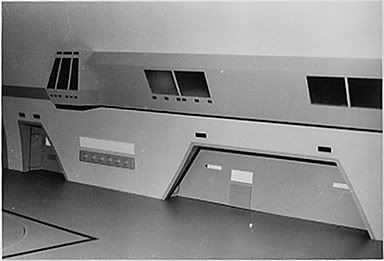
And here is the color close-up that is supposedly a shot of the same and original VFX model:

In the color shot the photpgrapher has moved closer to the port side wall and logically the inner shuttlebay wall is now shielding parts of the embayments from our view.
But the long embayment is not nearly deep enough to enable the inner shuttlebay wall to possibly shield that much of this embayment (and to get this close to the "Warning Fire" sign), IMO.
Also, in the original shot the "Elevators" black direction arrow is outside the white text field while in the close-up shot it is inside the white text field!
Happened to find this thread while googling for shuttlebay pictures, so let me put an end to the speculation - the two close-up color "photos" of the sides of the shuttlebay are definitely from my shuttlebay rendering for William McCullars' article about TOS filming miniatures in Star Trek Communicator #133, published in 2001. I didn't know it had been used anywhere else.
It was a pretty good recreation, but by no means perfect, as this debate illustrates.

Petri Blomqvist
It was a pretty good recreation, but by no means perfect, as this debate illustrates.
But an outstanding accomplishment I must add, thanks for the clarification.

What kind of reference materials did you use for the CGI rendering?
Your "fueling station" nozzles look pretty much like the real thing in these rare black & white photos of the original miniature.
And Alchemist said he had a high resolution camera negative scan suggesting the text above the nozzles to be "fueling station". How did you figure this one out?
I'm also relieved that Mr. Datin is no longer under suspicion for "misremembering" or senility. I'd say the quest to find original photpgraphs with the original text signs goes on.
Bob
My compliments to Petri Blomqvist on a build that I guessed was either the real deal or the work of Greg Jein.
And I tip my hat to Robert Comsol. You called it from the start.
And I tip my hat to Robert Comsol. You called it from the start.

Now he'll be impossible to live with.
I had hoped that my reaction to Petri Blomqvist's clarification suggested otherwise.

By the way, Mr. Blomqvist is the gentleman who provided essential CGI reproductions for the TOS remastering (which obviously required a lot of talent and we saw here how good he is).
Bob
I got it but just couldn't resist the temptation to use your comment as an opportunity to express myself. 
Bob

Bob
Boy, I step out for a six-year smoke break and all heck breaks loose! 
Thank you Ambassador Petri for clearing up that mystery, and thanks for your inspiring CGI work back in the early 2000's which got me into this maddening hobby.

Thank you Ambassador Petri for clearing up that mystery, and thanks for your inspiring CGI work back in the early 2000's which got me into this maddening hobby.

Boy, I step out for a six-year smoke break and all heck breaks loose!
Say, I did think I saw you standing out back on the other side of the loading dock.

After 47 years I'm afraid the treasure trove of heretofore unseen photographs from the original series is vanishingly small, if not non-existent. But ya never know...!
Hi, guys. Sorry to come back so late to this "revivified" thread.
First, I'm glad to have Petri confirm that he is the source of the color hangar shots from the ST Communicator article. Often things are run in magazines without proper captions or attribution.
Here's what I know about the model and the drawings.
I am the source of the idea that the TMOST drawings are of the forced perspective set. I had pored over them for years before I finally noticed that they do indeed have forced perspective details. If you distort these back out of it, you end up with something that is much closer to fitting in the available space. But keep in mind that MJ didn't have CAD modeling tools and a personal computer with Photoshop. Don't expect it to come out perfectly when you warp it back into shape.
My theory about the drawings was that they found their way into the writers guide (and then into TMOST) as the real thing, rather than the set.
Later I corresponded with Richard Datin on the subject and he assured me that the miniature set (which he built) did not have forced perspective features. He said the walls were cylindrical.
I still maintain that the TMOST drawing is not the "real" hangar bay, but an early set concept; but the plans changed before construction. Later, they likely needed an illustration of the hangar for the writers guide and that one was ready to hand. One thing we KNOW they didn't have was an abundance of was extra time. It was good enough.
If you want to see what Jefferies really meant the hangar to be, look to his Phase II cross section. That is a real, scale drawing; and it is much shorter front to back and has galleries that are parallel with the deck and don't diminish in size as they go aft.
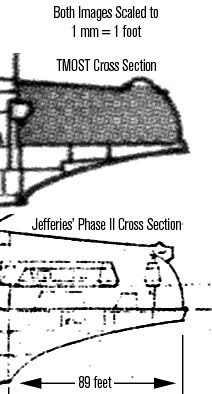
As for my virtual model, I really had to shoe-horn it in but I managed to make it fit in a way that looks pretty much like what we saw on screen. But as was mentioned up thread, you have to use a wide angle lens, and place the camera outside the forward bulkhead looking into the space to get the same view. In my version, the profile of the interior is cylindrical. This gives us more space behind the forward pocket doors. There is just enough space to have a room similar to the one visible in BABEL when the honor guard greets Sarek and Amanda (although you have to place the camera outside the hull of the ship to get the right angle). There is also just enough room behind the inner wall below the control booths for a curving ladder to ascend up into the booths. Here is a perspective cutaway view of my hangar (not finished yet in this image). The amount of space shown between the exterior and the interior at the top is the same that is available at the sides. You can also see into the port observation gallery to the view ports seen in COTK, and part of the port pylon interior structural support can be seen in the forward gallery:
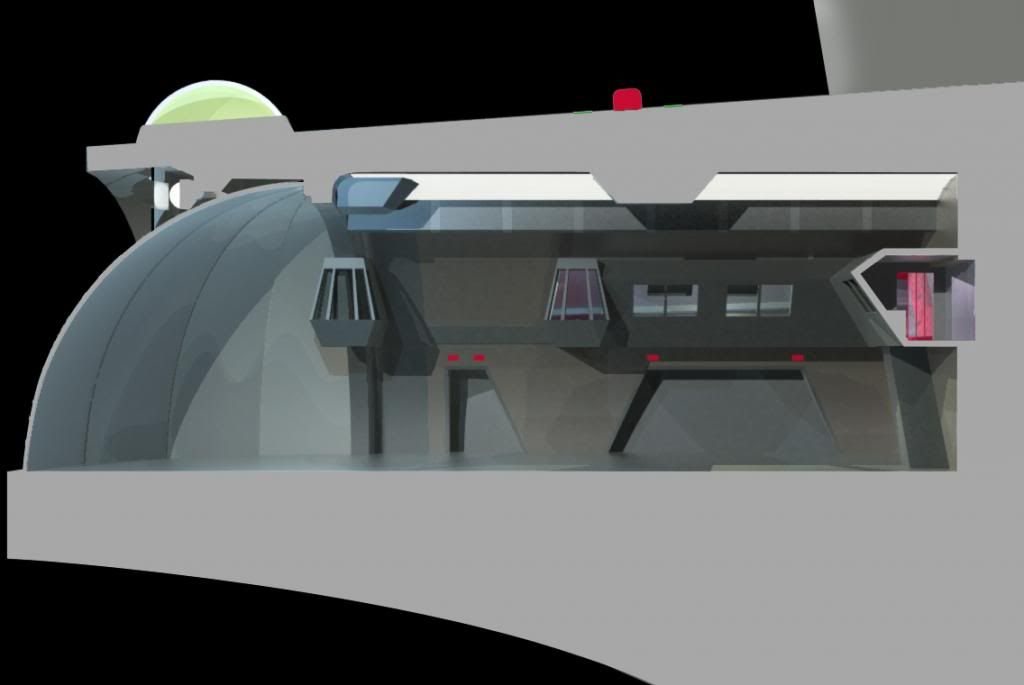
That's my 2 cents. Your mileage, of course, may vary...
M.
First, I'm glad to have Petri confirm that he is the source of the color hangar shots from the ST Communicator article. Often things are run in magazines without proper captions or attribution.
Here's what I know about the model and the drawings.
I am the source of the idea that the TMOST drawings are of the forced perspective set. I had pored over them for years before I finally noticed that they do indeed have forced perspective details. If you distort these back out of it, you end up with something that is much closer to fitting in the available space. But keep in mind that MJ didn't have CAD modeling tools and a personal computer with Photoshop. Don't expect it to come out perfectly when you warp it back into shape.
My theory about the drawings was that they found their way into the writers guide (and then into TMOST) as the real thing, rather than the set.
Later I corresponded with Richard Datin on the subject and he assured me that the miniature set (which he built) did not have forced perspective features. He said the walls were cylindrical.
I still maintain that the TMOST drawing is not the "real" hangar bay, but an early set concept; but the plans changed before construction. Later, they likely needed an illustration of the hangar for the writers guide and that one was ready to hand. One thing we KNOW they didn't have was an abundance of was extra time. It was good enough.
If you want to see what Jefferies really meant the hangar to be, look to his Phase II cross section. That is a real, scale drawing; and it is much shorter front to back and has galleries that are parallel with the deck and don't diminish in size as they go aft.

As for my virtual model, I really had to shoe-horn it in but I managed to make it fit in a way that looks pretty much like what we saw on screen. But as was mentioned up thread, you have to use a wide angle lens, and place the camera outside the forward bulkhead looking into the space to get the same view. In my version, the profile of the interior is cylindrical. This gives us more space behind the forward pocket doors. There is just enough space to have a room similar to the one visible in BABEL when the honor guard greets Sarek and Amanda (although you have to place the camera outside the hull of the ship to get the right angle). There is also just enough room behind the inner wall below the control booths for a curving ladder to ascend up into the booths. Here is a perspective cutaway view of my hangar (not finished yet in this image). The amount of space shown between the exterior and the interior at the top is the same that is available at the sides. You can also see into the port observation gallery to the view ports seen in COTK, and part of the port pylon interior structural support can be seen in the forward gallery:

That's my 2 cents. Your mileage, of course, may vary...
M.
@ MGagen
That's a beautiful cross-section you are sharing with us, thanks!
But I notice that you made the ceiling beams parallel to the flight deck rather than to align these with the outer hull.
Two of these magnificient five original shots you thankfully provided suggest that also on the model the ceiling beams were angled:
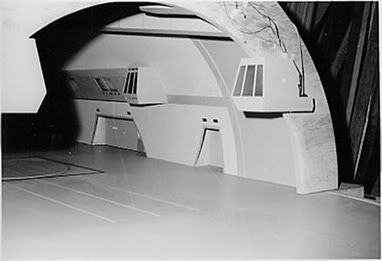
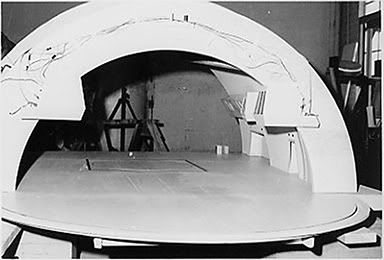
Apparently the angle of the ceiling beams wouldn't match the back of the ship "in-universe" but given the choice to either make them parallel to the exterior hull or the flight deck, what was your motivation to make these parallel to the flight deck?
Bob
That's a beautiful cross-section you are sharing with us, thanks!
But I notice that you made the ceiling beams parallel to the flight deck rather than to align these with the outer hull.
Two of these magnificient five original shots you thankfully provided suggest that also on the model the ceiling beams were angled:


Apparently the angle of the ceiling beams wouldn't match the back of the ship "in-universe" but given the choice to either make them parallel to the exterior hull or the flight deck, what was your motivation to make these parallel to the flight deck?
Bob
Similar threads
- Replies
- 10
- Views
- 3K
- Replies
- 482
- Views
- 58K
- Replies
- 6
- Views
- 2K
If you are not already a member then please register an account and join in the discussion!
